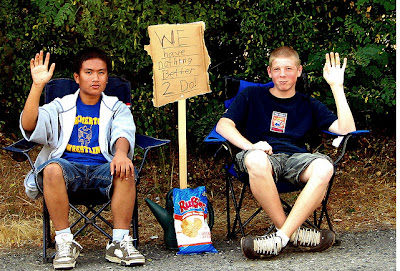The Chemung Valley History Museum wanted to develop a new exhibition. We began the process by talking with several groups of local residents, including a high school history class. There was uniform agreement in all the groups that the sort of chronological presentation that characterizes most long-term local history exhibits was not interesting to most people (been there, done that, they said). But, said a student, "wouldn't it be cool if you could see how people our age lived? what their lives were like?" There have been some other great exhibits on teenagers (Chicago and New Jersey) but we wanted to see what it might be like here. We asked non-teenage groups about what they thought--and suddenly their faces lit up and they began discussing their own teenage years. Teenagers it would be.
Often, this kind of idea languishes until a museum staff finds funding to pursue the next step. But the team in Elmira decided all the resources needed were enthusiasm and a bit of time. They held community conversations with several local groups of seniors and set a booth asking for information at the county fair.
This week, we sat down with that information to think about what we'd learned and what the next steps might be. I'd read the summaries of the conversations and so decided to make objects and location as starting frames. Armed with our hand post-it notes, we listed all the objects mentioned in the conversations and began to sort them into thematic groups. Almost immediately, we noticed something: clothes were most often mentioned and we recalled a comment early on in the process from a community member, "don't make it just about poodle skirts." Because, it's the top of mind. But we wanted to think harder. We then went back and listed objects that were implied in the conversations and added them (those are the circled ones) to our growing wall. How many of these 20th objects are in the museum's collections? Very few. And we found unexpected objects: under a theme of work, lawnmowers, newspapers, diapers all were mentioned in discussions of first jobs.
What themes did we see in our object post-its? Independence, gender, romance, big world issues. What themes did we not see? Cultural diversity, the role of religion, class, and neighborhoods. We know those themes exist in this community, but we now know we need to work a bit harder on collecting that information.
We wondered if some of these issues might be found by thinking about places mentioned--so we posted those in a rough county map, above. That helped us see neighborhoods better, but also, with these two notes below, note the way that the outside world had enormous effects on teenagers.
This iterative process--where we talk to each other and community members, reflect, and go back out and talk again, is not only an exhibit building process--it's a community building process. (and for me, because this is the city where I grew up, a fascinating exercise in individual and collective memory). It's becoming clear that ownership of this exhibit will not be solely the museum's, but rather something that is created--and changed on an ongoing basis-- by the people whose stories we share.









